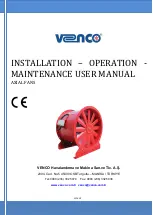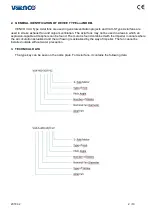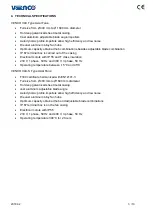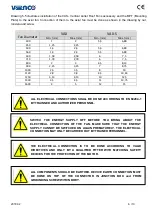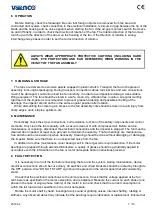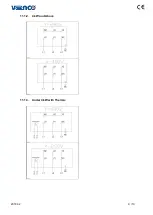
2018.02
7 / 10
6. OPERATION
Before starting, check the followings; Be sure that foreign objects are removed from fan area and
connected duct system, check connection to the electrical installation, minimum air gap between the tip of the
blade and the housing and no noise appears when starting the fan. If the air gap is correct, switch the device
on and off briefly, in order to check the direction of rotation of the fan. The rotation direction of the fan must
match up with the direction of the arrow on the housing of the fan. If the direction of rotation is wrong,
interchange two phases in order to set the correct direction of rotation.
7. HANDLING & STORAGE
The fans are delivered on wooden pallets wrapped in plastic stretch. Transport the fan to the place of
assembly in its original packaging. During transport, connection cables, terminal box and wire connections
mustn’t be damaged. Load and unload the fan carefully, in order to avoid possible damage. Use suitable
lifting equipment. The fan should be stored in a safe, clean, dry, vibration free, location. A regular monthly
rapid spin of the impeller is recommended to prevent grease hardening and possible brinelling of the
bearings; the impeller should not be in the same angular position after rotation.
When dismantling the crate to gain access to the fan assembly care should be taken to avoid injury from
sharp edges, nails, staples, splinters, etc.
8. MAINTENANCE
Periodically check the screw connections, coil resistance, function of the safety components and control
elements. Only clean the fan manually, with a vacuum cleaner or with compressed air. Before service,
maintenance or repairing, disconnect the electrical connections and the impeller is stopped. The fan must be
cleaned when needed, at least once per year to maintain the capacity. The fan bearings are maintenance-
free and should be renewed only when necessary. Cleaning should be done without dislodging or damaging
the impeller. Make sure that there is no unexpected noise from the fan.
In addition to routine maintenance motor bearings will in the longer term require attention. If the motor
bearings are greased through extended lubricators, a quality of grease should be periodically applied in
accordance with the information on the fan or motor nameplate and/or instructions provided.
9. FAULT DETECTION
It is necessary to turn off the fan before checking the fan and the system. During maintenance, device
electrical connections should be cut entirely. All switches and circuit breakers should be locked by brought to
the OFF position. Also “DO NOT START” sign should be placed on the control panel that will consistently
stand.
Check that the electrical connections to the unit are secure. Check that the voltage applied at the fan
terminals is as specified on the motor nameplate, and is balanced. Measure the current on each phase (one
phase in the case of single-phase motors) of the motor in turn and check that the current consumption is
within the full load current specified on the motor nameplate.
Rotate the motor shaft by hand. Investigate any sound of grinding noises, internal chaffing, rubbing or
stiffness. Any observed defect may indicate that the bearings require lubrication or replacement. Ensure that
ALWAYS WEAR APPROPRIATE PROTECTIVE CLOTHING (INCLUDING HARD
HATS, EYE PROTECTORS A
ND EAR DEFENDERS) WHEN WORKİNG IN THE
VICINITY OF THE FAN ASSEMBLY

